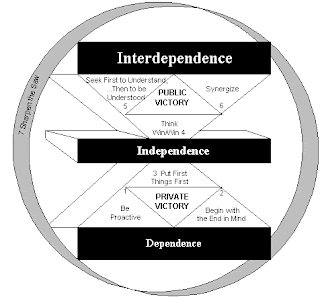If you read/follow the work of Stephen R. Covey, then you have already recognized this as Habit Number 5 from the 7 Habits of Highly Effective People.
 |
| source: http://stevecolwell.com/7habits.html |
If you don’t, then there’s a chance that this phrase may come off as sort of a cliche. Let’s explore how essential this practice is in effective communication: Understanding your respondent; Seeking to gather as much information as possible before you respond.
As simple as it may it sound, I still find it the number one challenge in business and personal communications: the ability to put yourself in the other person s shoes (metaphorically, that is). The analogy I will present next is my aim at materializing this practice (seeking first to understand) and clarifying it.
I’ve developed a useful habit while driving over the past few years. I find this new habit particularly helpful considering the strict driving laws in the State of Arizona. Recently, I’ve started applying the learning from this driving habit to everyday communications, and the results: fascinating.
The Habit: As I drive I always look beyond the driver ahead of me. I focus more on the cars in front of them rather than on this driver s behavior. This usually improves my reaction time and helps me better understand the driving dynamic.
The application: How does this help communication? Simple: imagine a normal conversation as a driving experience. You steer the conversation as you would drive your car: to get to places/destinations. Now imagine yourself as driver A. Imagine the person you are talking to as driver B (the car right in front of you on the freeway). And imagine all other concerned individuals to be drivers C,D,E all driving in front of Driver B.
As driver A, you are less prone to colliding with driver B when you understand how driver B is reacting/interacting with drivers C,D,E If you notice driver C coming to a sudden stop, you will focus more on slowing down BEFORE reacting to driver B s sudden stop.
Now apply that same logic to a human interaction: In order to better interact with someone, you need to first know why they behave as they do, how are they reacting to their surroundings, what drives/motivates them. These are the things you need to understand first, BEFORE attempting to put your points across.
Several years back, I applied habit number five with a client and it resulted in a successful communication flow. I was handling an account with a client who was continuously angry, and hence aggressive in their approach to matters at hand. A few months of having to deal with this, I found out 2 facts that shifted my paradigm:
1-The client was in fact a working parent, who due to the excessive amount of business trips was experiencing frustration and disconnect with their 2 year old daughter.
2-I stumbled upon a survey result that said ‘Working parents, are the employees with the highest amount of stress levels’
Knowing these 2 facts made for a much smoother approach to my angry client. I understood the nature of their behavior was in no way related to the quality of work or the people that are delivering it.
In conclusion, Habit number 5 (Seeking first to understand, then to be understood) can be put to use by understanding that: the best relationship you (driver A) can have with someone else (driver B) is to understand how they are acting in response to other individuals (drivers C,D,E ).

Comments
Post a Comment